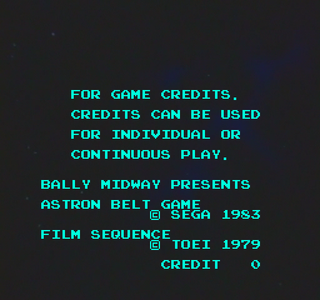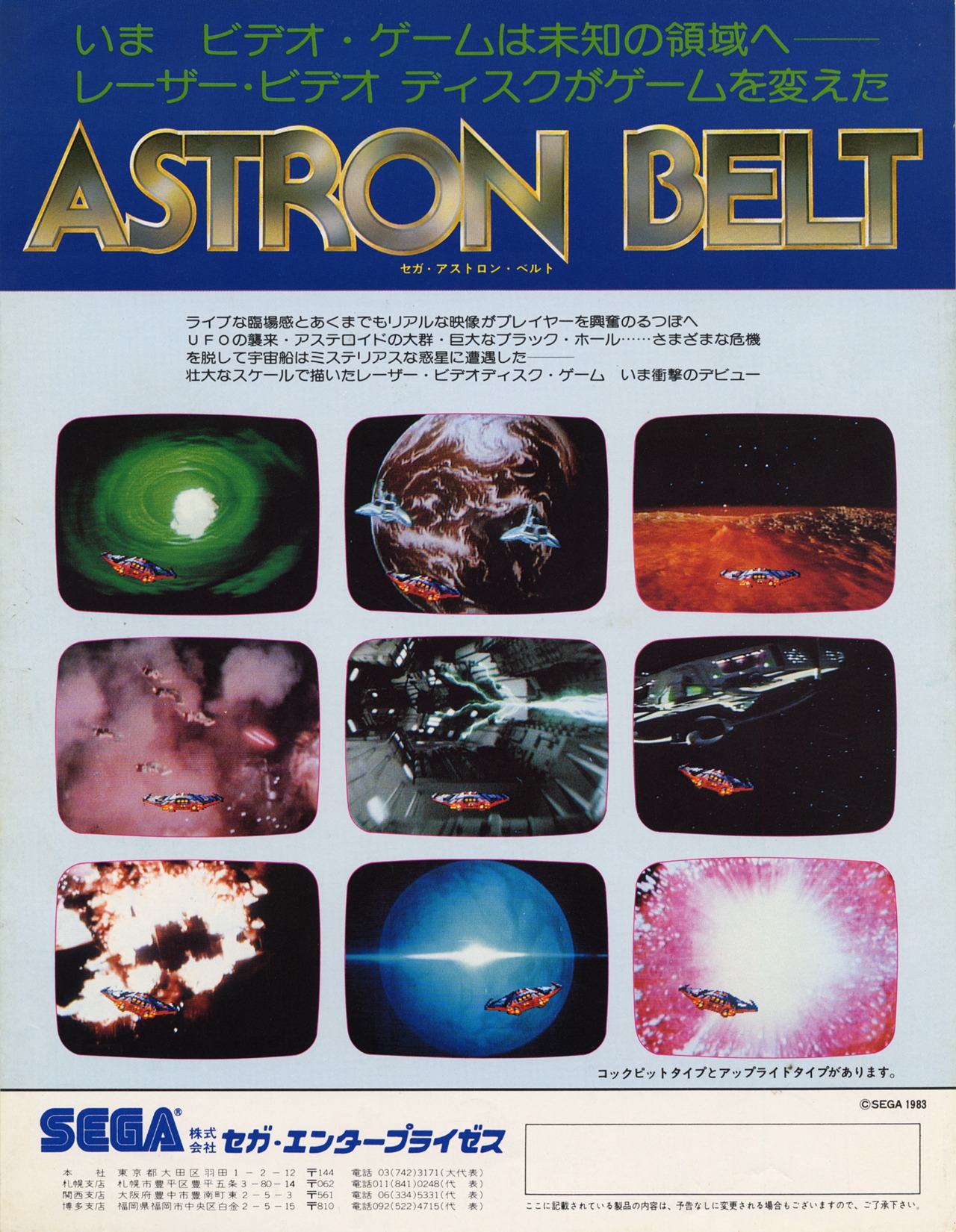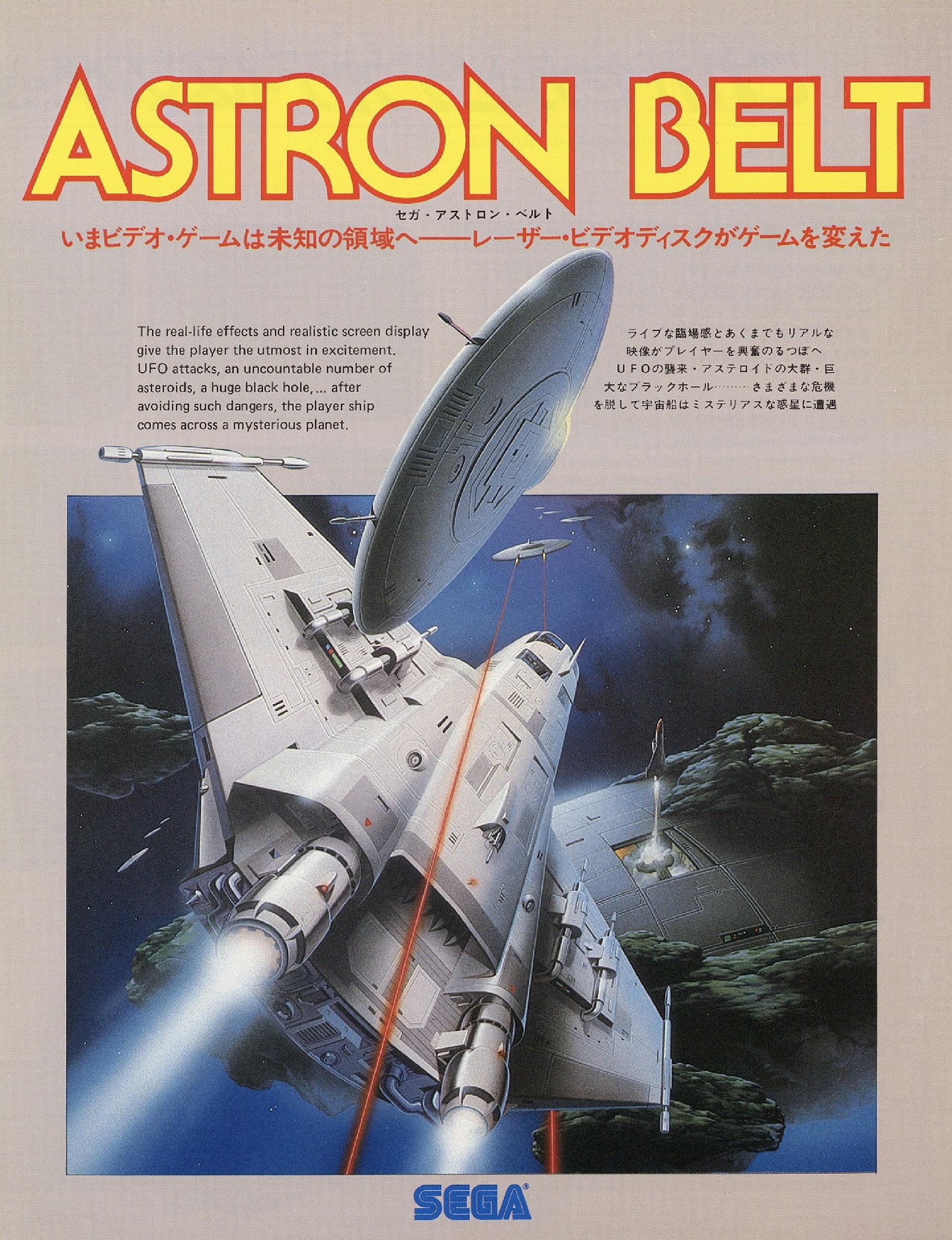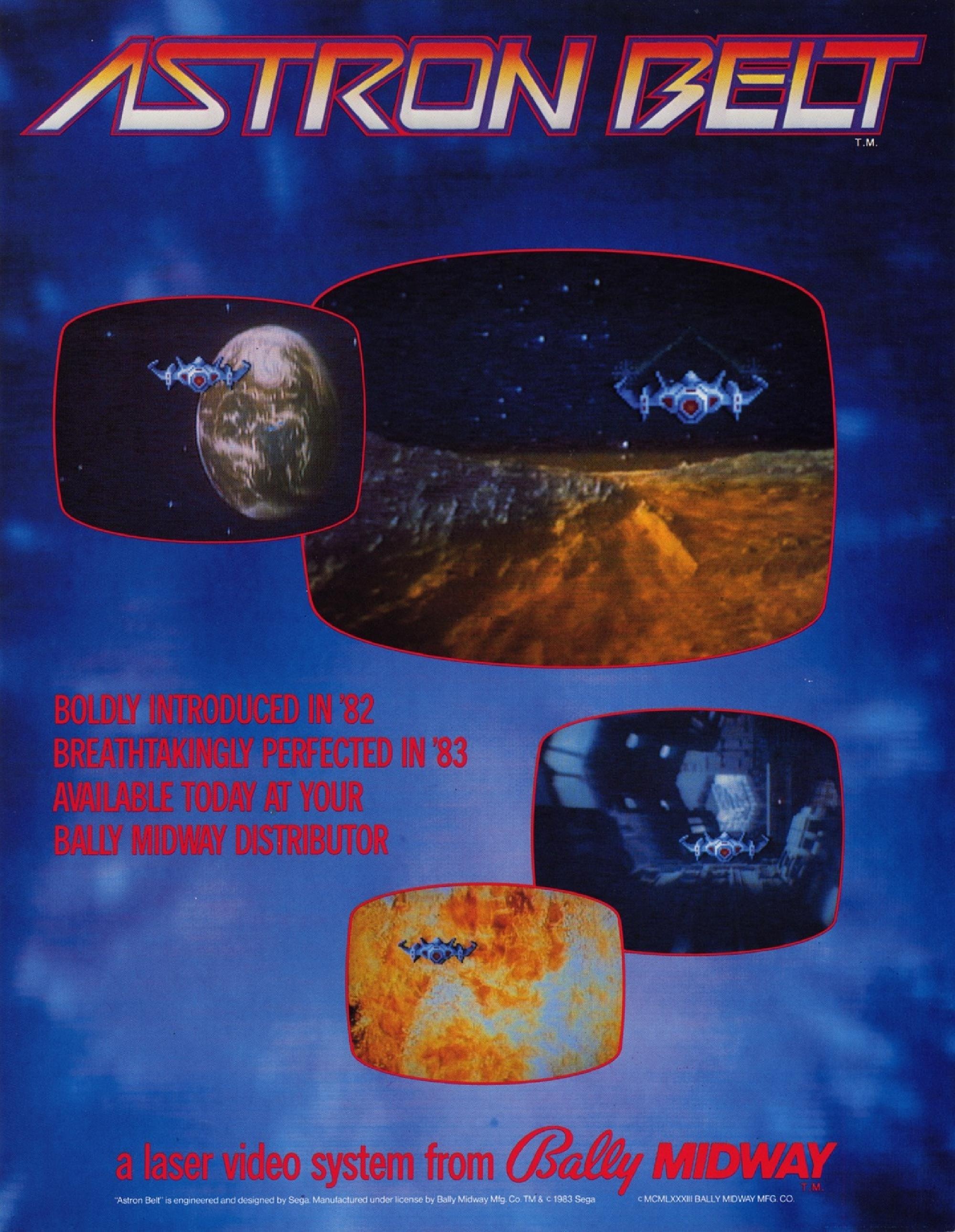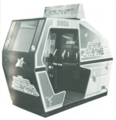Difference between revisions of "Astron Belt"
From Sega Retro
m |
|||
| Line 34: | Line 34: | ||
==History== | ==History== | ||
===Development=== | ===Development=== | ||
| − | ''Astron Belt'' was demonstrated at [[Amusement Machine Show 1982]] (September) and [[AMOA 1982]] (November), drawing crowds for its use of LaserDisc technology, and igniting a discussion about the future of video games. At the time, video game | + | ''Astron Belt'' was demonstrated at [[Amusement Machine Show 1982]] (September) and [[AMOA 1982]] (November), drawing crowds for its use of LaserDisc technology, and igniting a discussion about the future of video games. At the time, video game graphics were primitive, using low-colour, sprite/tile-based graphics at low resolutions, while ''Astron Belt'' could display what appeared to be full-colour, full screen, 60FPS LaserDisc-quality video. While the original showings were incomplete and buggy, the game would inspire a series of LaserDisc-based arcade games from developers from both sides of the Pacific. |
''Astron Belt'' is credited as the first game to use LaserDisc technology,{{magref|sv|11|80}} and was the first laserdisc game released in Japan (in early 1983) and Europe (in mid-1983).{{magref|cvg|22|30}} While ''Astron Belt'' was announced and demonstrated first, and was released in Japan and Europe first,{{magref|cvg|22|30}} [[Cinematronics]] was able to demonstrate and then release the 1983 hit ''[[Dragon's Lair]]'' (said to have been inspired by ''Astron Belt'''s showing at AMOA 1982) before Sega's game made it to US shores. ''Dragon's Lair'' is said to have taken six months to develop. It was not initially envisioned as a LaserDisc arcade game until after Astron Belt was demonstrated in 1982. Another early laserdisc game was ''Quarter Horse'', a lesser known game based on horse racing, which was released in 1983;{{ref|http://www.dragons-lair-project.com/games/materials/flyers/qh.asp}} ''Quarter Horse'' lacks the same level of interaction and was distributed in much smaller numbers, but uses full-screen LaserDisc video to show horse racing sequences. | ''Astron Belt'' is credited as the first game to use LaserDisc technology,{{magref|sv|11|80}} and was the first laserdisc game released in Japan (in early 1983) and Europe (in mid-1983).{{magref|cvg|22|30}} While ''Astron Belt'' was announced and demonstrated first, and was released in Japan and Europe first,{{magref|cvg|22|30}} [[Cinematronics]] was able to demonstrate and then release the 1983 hit ''[[Dragon's Lair]]'' (said to have been inspired by ''Astron Belt'''s showing at AMOA 1982) before Sega's game made it to US shores. ''Dragon's Lair'' is said to have taken six months to develop. It was not initially envisioned as a LaserDisc arcade game until after Astron Belt was demonstrated in 1982. Another early laserdisc game was ''Quarter Horse'', a lesser known game based on horse racing, which was released in 1983;{{ref|http://www.dragons-lair-project.com/games/materials/flyers/qh.asp}} ''Quarter Horse'' lacks the same level of interaction and was distributed in much smaller numbers, but uses full-screen LaserDisc video to show horse racing sequences. | ||
Revision as of 21:34, 16 December 2023
| Astron Belt | ||||||||||||||||||||||||||||||
|---|---|---|---|---|---|---|---|---|---|---|---|---|---|---|---|---|---|---|---|---|---|---|---|---|---|---|---|---|---|---|
| System(s): Sega LaserDisc Hardware, MSX | ||||||||||||||||||||||||||||||
| Publisher: Sega (JP,EU) Bally Midway (US) LaserDisc Corporation | ||||||||||||||||||||||||||||||
| Developer: Sega | ||||||||||||||||||||||||||||||
| Supporting companies: Toei (film sequence) | ||||||||||||||||||||||||||||||
| Genre: Shoot-'em-Up | ||||||||||||||||||||||||||||||
| Number of players: 1 | ||||||||||||||||||||||||||||||
|
This teeny-tiny article needs some work. You can help us by expanding it.
Astron Belt (アストロンベルト) is an arcade game developed by Sega, first demonstrated in 1982 and then released in 1983. It was the first laserdisc game, running on the Sega Laserdisc hardware. It was later ported to the MSX computer in 1984.
Contents
Gameplay
Astron Belt is a shoot-'em-up, where the player controls a spaceship which must destroy on-screen enemies and avoid obstacles.
The laserdisc technology could mean that very detailed background scenes could be created with high quality sound, though the player's sprite and HUD are rendered separately. Though laserdisc games look and sound better than non-laserdisc games of the era, gameplay is very limited, with the player only being able to move around the screen and fire. Unlike most laserdisc games however, Astron Belt is not quite as linear as the scenes are generated at random depending on the player's actions.
History
Development
Astron Belt was demonstrated at Amusement Machine Show 1982 (September) and AMOA 1982 (November), drawing crowds for its use of LaserDisc technology, and igniting a discussion about the future of video games. At the time, video game graphics were primitive, using low-colour, sprite/tile-based graphics at low resolutions, while Astron Belt could display what appeared to be full-colour, full screen, 60FPS LaserDisc-quality video. While the original showings were incomplete and buggy, the game would inspire a series of LaserDisc-based arcade games from developers from both sides of the Pacific.
Astron Belt is credited as the first game to use LaserDisc technology,[3] and was the first laserdisc game released in Japan (in early 1983) and Europe (in mid-1983).[2] While Astron Belt was announced and demonstrated first, and was released in Japan and Europe first,[2] Cinematronics was able to demonstrate and then release the 1983 hit Dragon's Lair (said to have been inspired by Astron Belt's showing at AMOA 1982) before Sega's game made it to US shores. Dragon's Lair is said to have taken six months to develop. It was not initially envisioned as a LaserDisc arcade game until after Astron Belt was demonstrated in 1982. Another early laserdisc game was Quarter Horse, a lesser known game based on horse racing, which was released in 1983;[4] Quarter Horse lacks the same level of interaction and was distributed in much smaller numbers, but uses full-screen LaserDisc video to show horse racing sequences.
A protracted development schedule meant that Astron Belt was not released in North America until the Autumn of 1983. Part of the reason for the delay is thought to have been Sega Electronics's sale to Bally Midway shorly before release, who promptly requested some changes to the gameplay. The early showing is thought to have hindered Astron Belt, as while it generated interest in the game, rivals were able to copy ideas and produce competing titles from scratch in a matter of months. By the time of Astron Belt's release, it was no longer cutting edge and other games were using the technology more effectively.
Also of note that while Dragon's Lair was immensely popular, the technology powering the game struggled within the first few months of operations. The LaserDisc drives produced by Pioneer were designed for the home, expecting to play long movies from beginning to end. In Dragon's Lair, however, the player was expected run continously and rapidly seek different sections of the disc (as dictated by gameplay). Players would overheat and break down, causing Pioneer to work with Cinematronics to engineer more suitable players for the arcade market. As Pioneer were one of the biggest names in the LaserDisc scene, all companies attempting to produce similar arcade games were likely affected by these issues.
Astron Belt's late release also saw it come into competition with similar LaserDisc shooters - M.A.C.H. 3 by Gottlieb would debut around the same time, while Atari's Firefox would debut later in the year.
Though most of the background scenes were created specifically with Astron Belt in mind, some are borrowed from movies such as Star Trek II: The Wrath of Khan, Battle Beyond the Stars and Message from Space.
Legacy
Astron Belt only saw one release outside of arcades - a port to the MSX computer range through the laserdisc add-on. It is virtually identical to the arcade version, as the laserdisc itself is identical.
Astron Belt was followed by Galaxy Ranger which was also a laserdisc shooter. The two arcade games can be interchanged by swapping the disc, game ROMs and sound board.
Magazine articles
- Main article: Astron Belt/Magazine articles.
Promotional material
also published in:
- Amusement Life (JP) #5: "No.5" (1983-05-10)[5]
- Amusement Life (JP) #6: "No.6" (1983-06-10)[6]
- Amusement Life (JP) #7: "No.7" (1983-07-10)[7]
- Amusement Life (JP) #8: "No.8, 9" (1983-08-20)[8]
Artwork
Physical scans
Arcade version
| Arcade, JP | ||||
|---|---|---|---|---|
MSX version
Specifications
Dimensions
| Cockpit | Upright |
|---|---|
|
|
|
| Mass: 238 kg (524 lbs) | Mass: 148 kg (326 lbs) |
Photo gallery
References
- ↑ Sega Arcade History, Enterbrain, page 51
- ↑ 2.0 2.1 2.2 Computer & Video Games, "August 1983" (UK; 1983-07-16), page 30
- ↑ Sega Visions, "February/March 1993" (US; 199x-xx-xx), page 80
- ↑ http://www.dragons-lair-project.com/games/materials/flyers/qh.asp
- ↑ Amusement Life, "No.5" (JP; 1983-05-10), page 130
- ↑ Amusement Life, "No.6" (JP; 1983-06-10), page 127
- ↑ Amusement Life, "No.7" (JP; 1983-07-10), page 119
- ↑ Amusement Life, "No.8, 9" (JP; 1983-08-20), page 111
- ↑ 9.0 9.1 File:AstronBelt_LaserDisc_JP_Flyer_Alt.pdf
